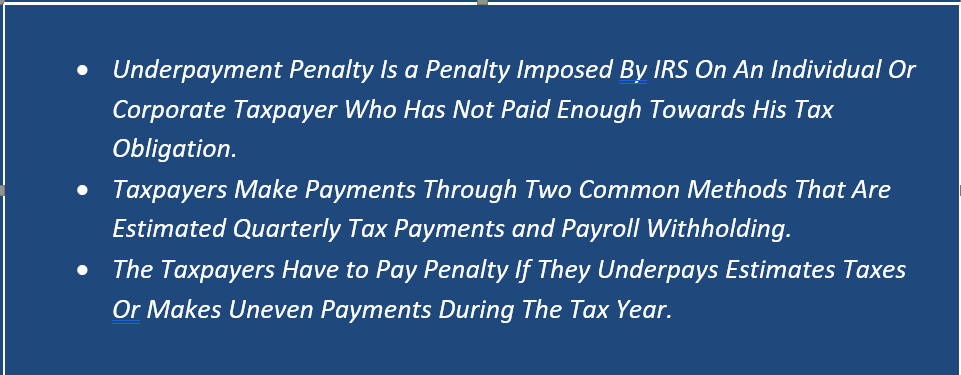What is an Underpayment Penalty?
Underpayment Penalty is a penalty imposed by IRS on an individual or corporate taxpayer who has not paid enough towards his tax obligation and withholding due throughout the year. An individual or businesses are subject to underpayment penalty use Form 1040 or 1040A to determine the amount and Form 2210 is used to report the payment. The US has tax-as-you-go tax system, which means taxpayers are expected to pay income tax as they earn their income in a tax year.
Taxpayers make payments through two common methods that are estimated quarterly tax payments and payroll withholding. In case, taxpayers withholding is not sufficient to cover ultimate tax obligation, taxpayers have to pay an underpayment penalty.
Taxpayers can use the following guidelines to see of their withholding is sufficient:
- Pay either 100% tax of last year
- Or 90% tax of the current year
- Or tax return shows you owe less than US $1,000

How Underpayment penalties work
To avoid underpayment penalties, taxpayers need to pay either 100% of the previous year income tax obligation or 90% of the income tax obligation for the year.
The taxpayers have to pay penalty if they underpays estimates taxes or makes uneven payments during the tax year that result in net underpayment. IRS Form 2210 is used to determine the amount of taxes, deducting the amount already paid in estimated taxes during the tax year.
If the taxpayer understands that they have outstanding tax, they may pay the difference, plus a penalty which is not a static percentage or flat dollar amount. It is based various things such as the period in which taxes were underpaid and the total underpayment amount.
The amount of penalty is determined based on how long the amount has been overdue and the outstanding amount owned. Normally, these penalties are around 0.5% of the outstanding amount; they are capped at 25%.
Interest Payments
Outstanding taxes also accrue interest at a rate the IRS sets annually. The IRS decides the interest rate each quarter on the bases of the federal short-term rate, plus 3% points for most individual taxpayers.

Source: Copyright © 2021 Kalkine Media
For the fourth quarter, the interest rates are:
- 3% for individual outstanding payments
- 5% for large business outstanding payments (exceeding $100,000)
How to calculate the Penalty
Penalty is determined on the tax shown on the taxpayer’s original return or on a more recent return that the taxpayer filed on or before the due date. The tax shown on the return is the total tax minus total refundable credits.
Penalty is calculated on the bases of:
- The amount of underpayment
- The interest rate for underpayment
- Period when the underpayment was due and underpaid.
Exceptions for underpayment penalties
In some cases, taxpayers do not have to pay underpayment penalty as IRS waives the penalty for the following situations:
- Taxpayers retired during the tax year after reaching age 62.
- Taxpayer was unable to make sufficient quarterly payments due to a natural casualty, disaster, or unforeseen circumstance.
- Taxpayer became disable during the tax year.
- Taxpayer’s total tax liability is less than US $1,000.
- No that is outstanding for the previous year.
- Taxpayer has paid 90% of the taxes from previous year.
- Any other situation where the underpayment was the result of reasonable cause, not willful negligence.
Special Considerations
Those who do not qualify for the exceptions for underpayment penalties mentioned above may nonetheless qualify for a reduced penalty in some situations. A reduction may be extended to an individual taxpayer who changed its tax filing status to married filing jointly may be afforded a reduced penalty due to larger standard deduction and also to the taxpayer who generate significant portions of their income late in the calendar year.
Special Rules for Farmers and Fishermen
IRS offers special rules for farmers and fishermen that include:
- If minimum two-third (66.67%) of taxpayers gross income comes from farming or fishing, complete Form 2210-F, Underpayment of Estimated Tax by Fishermen and Farmers.
- Qualifying farmers or fishermen must have to pay whichever amount is less from two-third (66.67%) of their tax, or 100% of the tax shown on the tax return for previous year.
 Please wait processing your request...
Please wait processing your request...